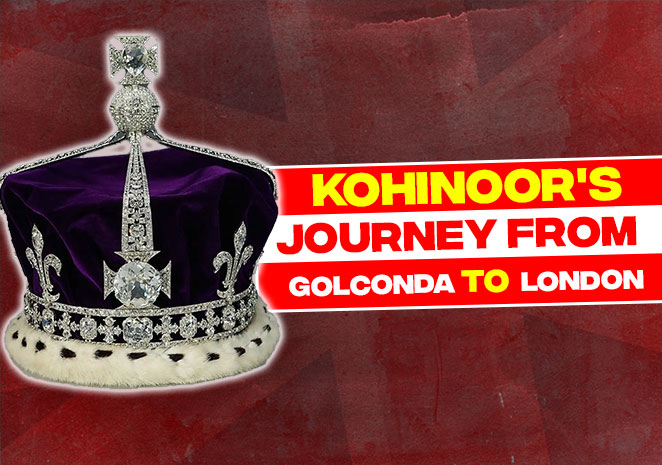
Kohinoor – the most valuable gem in the world, was described as “the diamond worth the value of day’s food for the people across the globe” by Mughal Emperor Babur, was originally owned by the Kakatiyas of Warangal. Moreover, this legendary gem, never purchased or sold, passed through numerous dynasties before reaching London, including the Khiljis, the Mughals, the Persians, the Afghans, and the Britishers.
Talking about its discovery, the Kohinoor diamond, weighing 793 carats, was found in the Golconda mines in the 13th century, during the rule of the Kalatiyas. The Golconda fort situated in Hyderabad, Telangana, is a centre of attraction for tourists all across the country. Additionally, Golconda is known for its diamond mines, especially the Kollur mine.
Also read: Buying A 14 Series iPhone From The US: A Good Idea? Here’s All You Need To Know!
Furthermore, in the 14th century, when Alauddin Khilji attacked the Southern Kingdoms, During these loots, Khilji’s general Malik Kafur acquired the Kohinoor diamond for the Khilji dynasty, the sultanate of Delhi.
In 1952, Ibrahim Lodi was soundly defeated by Babur in the Battle of Panipat. Moreover, Babur, after the battle, learned that the Fort of Agra was home to one of the biggest valuable treasures, including a diamond whose worth couldn’t be defined in words. As mentioned in the autobiography of Babur, he was so enamoured with the gem that he named it the “Diamond of Babur”.
After Babur’s death, the precious gem was passed on to Humayun, and then the other successive Mughal rulers. Shah Jahan, the fifth emperor of the Mughal Empire from 1628-58. Under his rule, the Mughals shined in the field of architecture. Shah Jahan, placed the Kohinoor in his eminent Peacock throne. However, Shah Jahan was later jailed by his son Aurangzeb.
Shockingly, Aurangzeb entrusted the work of cutting and resizing the Kohinoor diamond, reducing its weight from 793 to 186 carats, almost 4.5 times of the original weight. Furthermore, in 1739, the Shah of Persia – Nadir Shah invaded Delhi, under the rule of Muhammad Shah (Aurangazeb’s grandson). His army captured almost all the royal gems and treasures of the Mughals, including the Peacock throne and Daria-i-noor (Kohinoor’s sister diamond).
Muhammad Shah used to carry Kohinoor in the folds of his royal turban, which was a secret. However, when Nadir Shah came know about this secret, he ordered a grand feast. During the feast, as a gesture of friendship, Muhammad Shah couldn’t refuse to give his turban to Nadir Shah, and this is how the precious gem Kohinoor was passed over to Nadir Shah.
However, the Kohinoor was taken over by Ahmad Shah Abdali after Nadir Shah’s assassination. Furthermore, in 1813, the Kohinoor was brought back to India. Shah Shuja Durrani, an Abdali descendent, took the Kohinoor back to India in 1813 and presented it to Ranjit Singh, the ruler of Lahore, in return for his assistance in regaining the Afghan crown.
Kohinoor was fashioned into an armlet by Maharaja Ranjit Singh, the founder of the Sikh empire, and he wore it on all significant state events. He carried it with him for the following two decades. However, Maharaja Ranjit Singh passed away in 1839. It was his will to donate the diamond to the temple of Jagannath Puri, but the East India Company didn’t comply with his will’s terms.
Furthermore, Duleep Singh, the son of Maharaja Ranjit Singh, lost the second Anglo-Sikh War, which resulted in the British annexing the Punjab. The Kohinoor and the Maharaja’s other possessions were formally given to Queen Victoria as part of the Last Treaty of Lahore, which was negotiated under the supervision of Lord Dalhousie.
Finally, the Kohinoor left the Indian coast in the HMS Medea on April 6, 1850. Even the ship’s captain was unaware of the valuable gem his ship was carrying. The Kohinoor was formally presented to Queen Victoria by the East India Company officials at a large ceremony held in London’s Hyde Park.
However, the Queen didn’t like the shape of Kohinoor, moreover by the Mughal’s design. Furthermore, it was again reshaped, costing £8000, reducing its weight to 108.93 carats. Finally, it was set on the magnificent tiara for the Queen in 1853 that featured over 2000 diamonds.
Only the female members of the British Royal Family are allowed to wear the diamond. The Kohinoor has been worn by Queen Victoria, Queen Alexandra, Queen Mary, and Queen Elizabeth ever since it came into British hands. It is now on display in the Tower of London alongside the other British royal jewels. The Tower’s Jewel House also displays crystal replicas of the diamonds set in the oldest crowns and the real bracelet gifted to Queen Victoria.
So, this was the entire journey of the precious Kohinoor diamond from Golconda to London. No war or battle could ever reduce the shine or value of the Kohinoor, however, the Aurangzeb and then the Queen’s choice, led to reduce its size from 793 carats (originally) to 186 and now 108 carats.




